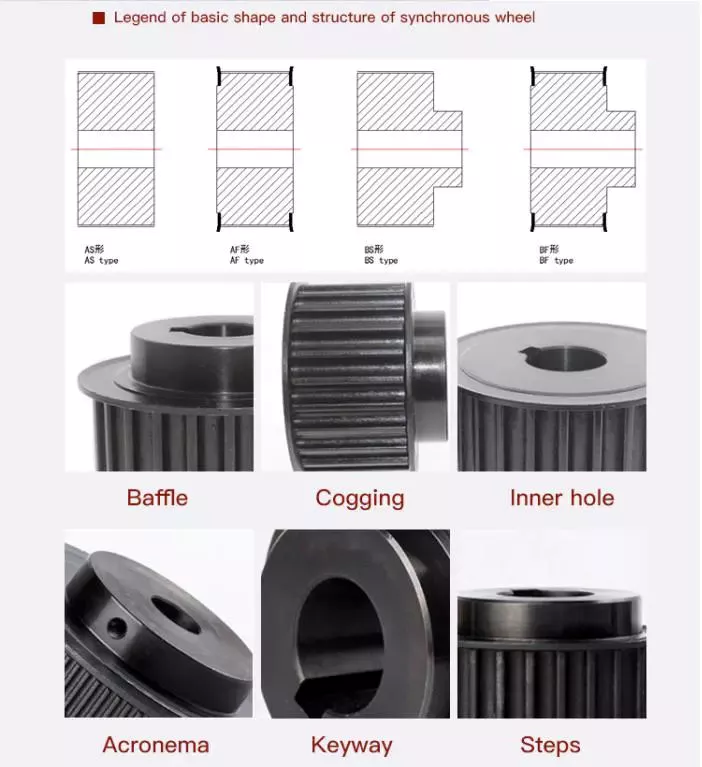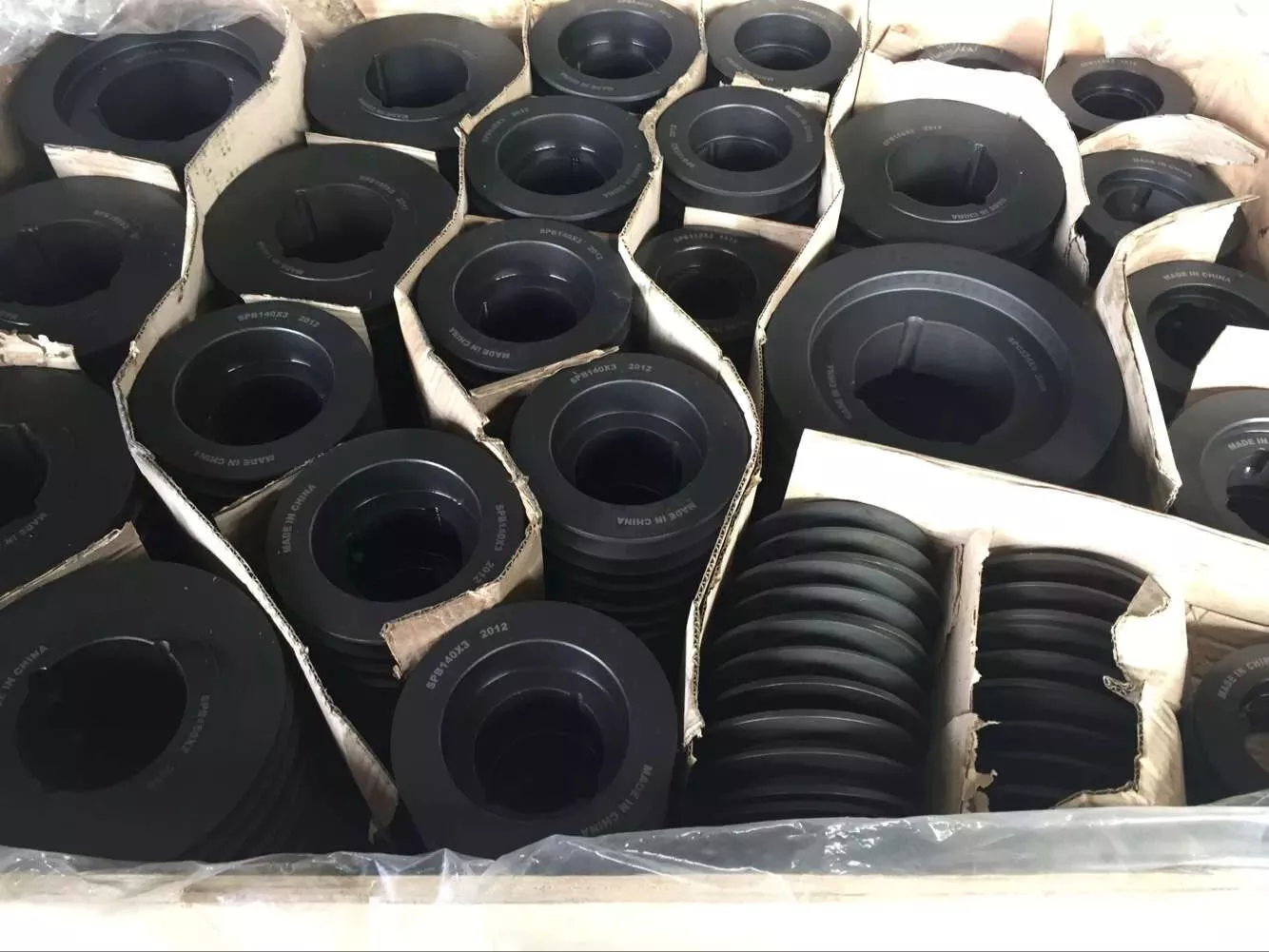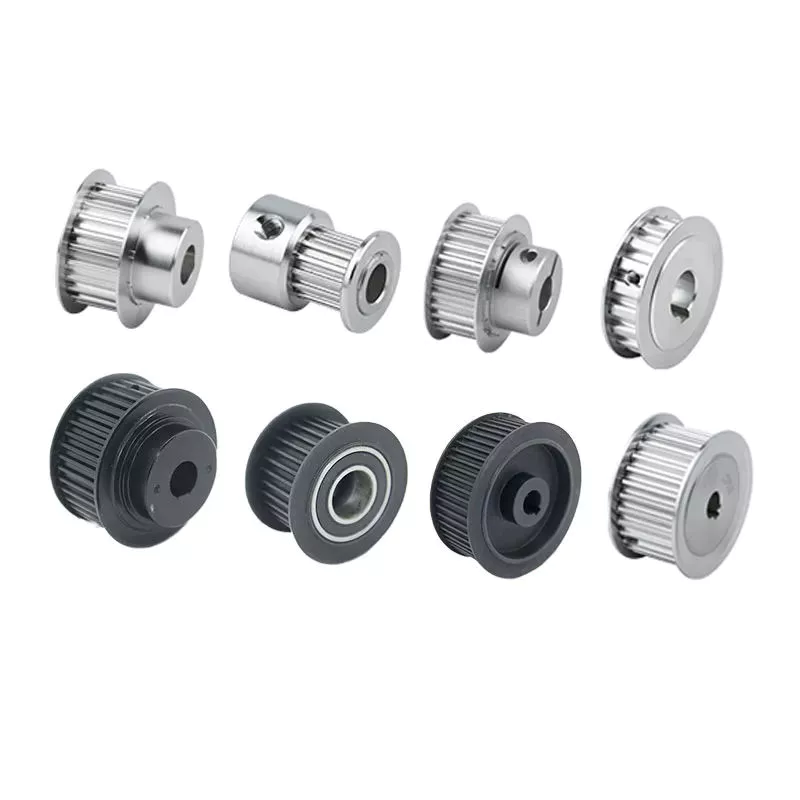Opis produktu
Opis produktu
Cast iron V belt pulley Cast Iron with Taper bore
With more than 15 years' experience, high-precision equipment and strict management system, CIMO can provide V belt pulley for you with stable quality and best service.
Cast Iron V Belt Pulley,V pulley, v belt pulley, v groove pulley, v groove belt pulley, taper lock pulley, taper lock v belt pulley, taper lock bushing pulley, taper lock pulleys / taper bore pulley, large v belt pulley, double v belt pulley, cast iron v belt pulley belt pulley, variable speed v belt pulleys, v belt pulley split pulley, cast iron v belt pulley
V belt pulley specifications:
1) European standard:
A) V-belt pulleys for taper bushings: SPZ, SPA, SPB, SPC; Up to 10 grooves
B) Adjustable speed V-belt pulleys and variable speed pulleys
C) Flat belt pulleys and conveyor belt pulleys
2) American standard:
A) Sheaves for taper bushings: 3V, 5V, 8V
B) Sheaves for QD bushings: 3V, 5V, 8V
C) Sheaves for split taper bushings: 3V, 5V, 8V
D) Sheaves for 3L, 4L or A, and 5L or B belts: AK, AKH, 2AK, 2AKH, BK, BKH, 2BK, 2BKH, 3BK
E) Adjustable sheaves: Poly V-pulley, multi-pitch H, L, J, K and M
3) Bore: Pilot bore, finished bore, taper bore, bore for QD bushing
4) Surface finish: Paint, phosphating, zinc plated
5) Material: Cast iron, ductile iron, nylon, aluminum
6) Made according to drawings and/or samples, OEM inquiries welcomed
| SPA56 | SPB56 | SPC56 | SPZ56 | 1008 |
| SPA63 | SPB63 | SPC63 | SPZ63 | 1108 |
| SPA67 | SPB67 | SPC67 | SPZ67 | 1210 |
| SPA71 | SPB71 | SPC71 | SPZ71 | 1215 |
| SPA75 | SPB75 | SPC75 | SPZ75 | 1310 |
| SPA80 | SPB80 | SPC80 | SPZ80 | 1610 |
| SPA85 | SPB85 | SPC85 | SPZ85 | 1615 |
| SPA90 | SPB90 | SPC90 | SPZ90 | 2012 |
| SPA95 | SPB95 | SPC95 | SPZ95 | 2017 |
| SPA100 | SPB100 | SPC100 | SPZ100 | 2517 |
| SPA106 | SPB106 | SPC106 | SPZ106 | 2525 |
| SPA112 | SPB112 | SPC112 | SPZ112 | 3571 |
| SPA118 | SPB118 | SPC118 | SPZ118 | 3030 |
| SPA125 | SPB125 | SPC125 | SPZ125 | 3525 |
| SPA132 | SPB132 | SPC132 | SPZ132 | 3535 |
| SPA140 | SPB140 | SPC140 | SPZ140 | 4030 |
| SPA150 | SPB150 | SPC150 | SPZ150 | 4040 |
| SPA160 | SPB160 | SPC160 | SPZ160 | 4535 |
| SPA170 | SPB170 | SPC170 | SPZ170 | 4545 |
| SPA180 | SPB180 | SPC180 | SPZ180 | 5040 |
| SPA190 | SPB190 | SPC190 | SPZ190 | 5050 |
| SPA200 | SPB200 | SPC200 | SPZ200 | 6050 |
| SPA212 | SPB212 | SPC212 | SPZ212 | |
| SPA224 | SPB224 | SPC224 | SPZ224 | |
| SPA236 | SPB236 | SPC236 | SPZ236 | |
| SPA250 | SPB250 | SPC250 | SPZ250 | |
| SPA265 | SPB265 | SPC265 | SPZ265 | |
| SPA280 | SPB280 | SPC280 | SPZ280 | |
| SPA300 | SPB300 | SPC300 | SPZ300 | |
| SPA315 | SPB315 | SPC315 | SPZ315 | |
| SPA335 | SPB335 | SPC335 | SPZ335 | |
| SPA355 | SPB355 | SPC355 | SPZ355 | |
| SPA400 | SPB400 | SPC400 | SPZ400 | |
| SPA450 | SPB450 | SPC450 | SPZ450 | |
| SPA500 | SPB500 | SPC500 | SPZ500 | |
| SPA560 | SPB560 | SPC560 | SPZ560 | |
| SPA630 | SPB630 | SPC630 | SPZ630 | |
| SPA710 | SPB710 | SPC710 | SPZ710 | |
| SPA800 | SPB800 | SPC800 | SPZ800 | |
| SPA900 | SPB900 | SPC900 | SPZ900 | |
| SPA1000 | SPB1000 | SPC1000 | SPZ1000 |
Detailed Photos
SPC560-10-5050
SPB1000-4-4040
Large stock in warehouse
Warsztat
Opakowanie i wysyłka
Export wooden box
Często zadawane pytania
Q1: Are you trading company or manufacturer ?
A: We are factory.
Q2: How long is your delivery time and shipment?
1.Sample Lead-times: 10-20 days
2.Production Lead-times: 30-45 days after order confirmed.
Q3: What is your advantages?
1. The most competitive price and good quality.
2. Perfect technical engineers give you the best support.
3. OEM is available.
/* January 22, 2571 19:08:37 */!function(){function s(e,r){var a,o={};try{e&&e.split(“,”).forEach(function(e,t){e&&(a=e.match(/(.*?):(.*)$/))&&1
| Orzecznictwo: | ISO |
|---|---|
| Rozmiary kół pasowych: | Type A |
| Proces produkcyjny: | Odlew |
| Tworzywo: | Iron |
| Surface Treatment: | Phosphated |
| Aplikacja: | Chemical Industry, Grain Transport, Mining Transport, Power Plant |
| Personalizacja: |
Dostępny
| Spersonalizowane żądanie |
|---|

What is the difference between a fixed and a swivel pulley?
Fixed and swivel pulleys are two common types of pulleys that differ in their design and functionality. Here are the key differences between these two types:
1. Fixed Pulley: A fixed pulley is a type of pulley that is mounted or attached to a fixed point, such as a beam or a ceiling. It does not move or rotate independently of its mounting point. The primary function of a fixed pulley is to change the direction of the force applied to a rope or cable. When a force is applied to the rope or cable passing through a fixed pulley, the load moves in the opposite direction. However, a fixed pulley does not provide any mechanical advantage, meaning it does not reduce the effort required to lift the load.
2. Swivel Pulley: A swivel pulley, also known as a movable pulley, is designed to rotate or swivel on a separate mounting point. It has a built-in mechanism that allows it to move independently. Unlike a fixed pulley, a swivel pulley is capable of changing both the direction and the magnitude of the force applied to the rope or cable. When a force is applied to the rope or cable passing through a swivel pulley, the load moves in the same direction as the applied force. Additionally, a swivel pulley provides a mechanical advantage by distributing the load's weight over multiple strands of rope or cable, reducing the effort required to lift the load.
In summary, the main differences between fixed and swivel pulleys are:
– Fixed pulleys are stationary and do not move independently, while swivel pulleys can rotate or swivel on a separate mounting point.
– Fixed pulleys change the direction of the force applied to the rope or cable, while swivel pulleys change both the direction and the magnitude of the force.
– Fixed pulleys do not provide a mechanical advantage, while swivel pulleys provide a mechanical advantage by distributing the load's weight over multiple strands of rope or cable.
Both fixed and swivel pulleys have their specific applications and can be used individually or in combination with each other to achieve desired mechanical functions in various systems and setups.

How are pulleys used in manufacturing processes and assembly lines?
Pulleys play a crucial role in manufacturing processes and assembly lines, facilitating the movement of materials, components, and products. They are utilized in various ways to enhance efficiency, increase productivity, and streamline production. Here's how pulleys are commonly used in manufacturing processes and assembly lines:
1. Conveyor Systems:
Pulleys are extensively employed in conveyor systems, which are integral to manufacturing and assembly lines. Conveyor belts or chains run over pulleys at different points along the line, transporting materials or products from one workstation to another. The pulleys help guide and support the conveyor belts or chains, ensuring smooth and controlled movement. By utilizing pulleys of different sizes or configurations, conveyor systems can be designed to accommodate various layouts, inclines, or speed requirements.
2. Material Handling:
Pulleys are used to facilitate the lifting, lowering, and movement of materials in manufacturing processes. Cranes, hoists, and lifting equipment often incorporate pulley systems to provide mechanical advantage and precise control over heavy loads. The pulleys, along with ropes, cables, or chains, allow operators to lift and position materials with minimal effort and improved safety.
3. Assembly Line Automation:
In automated manufacturing and assembly lines, pulleys are utilized in robotic systems to control the movement of robotic arms. The pulleys are incorporated into the mechanism that guides the cables or belts connected to the robotic arms. By adjusting the position and tension of the pulleys, precise and coordinated movements can be achieved, enabling efficient assembly processes.
4. Tensioning and Alignment:
Pulleys are crucial for maintaining proper tension and alignment in manufacturing processes. Tensioning pulleys are used to apply the appropriate tension to belts or chains, ensuring optimal power transmission and preventing slack or slipping. Alignment pulleys are employed to align belts or chains, minimizing wear, reducing vibrations, and prolonging the life of the components.
5. Power Transmission:
Pulleys are central to power transmission in manufacturing processes and assembly lines. They are used in conjunction with belts, chains, or gears to transfer rotational motion and power from one component to another. By selecting pulleys of different sizes or ratios, the speed and torque can be adjusted to suit specific production requirements.
6. Tool and Machine Positioning:
In manufacturing processes, pulleys are often integrated into tool positioning systems or adjustable machine setups. By using pulleys and cables, tools or machine components can be easily repositioned, allowing for quick changeovers or adjustments to accommodate different workpieces or production tasks.
Overall, pulleys are indispensable in manufacturing processes and assembly lines, enabling efficient material handling, precise movement control, proper tensioning and alignment, power transmission, and flexible tool positioning. Their use contributes to increased productivity, improved workflow, and enhanced automation in the manufacturing industry.

Czy koła pasowe można dostosować do konkretnych zastosowań?
Tak, koła pasowe można dostosować do konkretnych wymagań różnych zastosowań. Dostosowanie umożliwia dostosowanie kół pasowych do konkretnych rozmiarów, kształtów, materiałów i charakterystyk wydajności. Oto szczegółowe wyjaśnienie, w jaki sposób koła pasowe można dostosować:
1. Rozmiar i kształt: Koła pasowe można dostosować pod względem rozmiaru i kształtu, aby pasowały do konkretnych ograniczeń przestrzennych i układu zastosowania. Obejmuje to zmiany średnicy, szerokości, konfiguracji rowków i ogólnej konstrukcji. Niestandardowe rozmiary i kształty zapewniają optymalne dopasowanie i kompatybilność w systemie, umożliwiając wydajny i efektywny rozkład obciążenia i podnoszenie.
2. Materiały: Koła pasowe można dostosować na podstawie materiałów użytych do ich budowy. Różne materiały oferują różne właściwości, takie jak wytrzymałość, trwałość, waga i odporność na korozję lub zużycie. Wybierając odpowiednie materiały, koła pasowe można dostosować do konkretnych warunków pracy danego zastosowania, w tym temperatury, wilgotności i narażenia na działanie chemikaliów lub trudnych warunków środowiskowych.
3. Systemy łożyskowe: System łożysk koła pasowego można dostosować do wymagań aplikacji. Różne typy łożysk, takie jak łożyska kulkowe lub łożyska wałeczkowe, można wybrać na podstawie czynników takich jak nośność, prędkość obrotowa i pożądane charakterystyki tarcia. Dostosowanie systemu łożyskowego zapewnia płynny obrót, zmniejszone tarcie i ulepszoną ogólną wydajność koła pasowego.
4. Powłoki i obróbka powierzchni: Koła pasowe mogą być dostosowane do różnych powłok i obróbek powierzchni w celu zwiększenia wydajności. Na przykład koła pasowe używane w zastosowaniach, w których występują wysokie temperatury, mogą skorzystać z powłok odpornych na ciepło. Koła pasowe używane w środowiskach z substancjami żrącymi mogą być pokryte materiałami ochronnymi w celu zapobiegania korozji. Obróbki powierzchni, takie jak polerowanie lub powlekanie, mogą być również stosowane w celu zmniejszenia tarcia, poprawy odporności na zużycie lub zapewnienia określonych właściwości powierzchni.
5. Nośność i wydajność: Koła pasowe można dostosować do konkretnych wymagań dotyczących nośności i wydajności. Obejmuje to określenie liczby kół pasowych w systemie, wybór odpowiednich współczynników kół pasowych i skonfigurowanie układu kół pasowych w celu uzyskania pożądanej przewagi mechanicznej. Dostosowanie umożliwia optymalizację kół pasowych pod kątem konkretnych wymagań dotyczących obciążenia, zapewniając efektywny rozkład obciążenia i podnoszenie.
6. Integracja z systemami: Koła pasowe można dostosować, aby bezproblemowo zintegrować je z istniejącymi systemami lub urządzeniami. Obejmuje to projektowanie kół pasowych z kompatybilnymi interfejsami, opcjami montażu i metodami łączenia. Dostosowanie zapewnia prawidłowe wyrównanie, łatwą instalację i płynne działanie podczas włączania kół pasowych do całego systemu.
7. Zastosowania specjalistyczne: W niektórych specjalistycznych zastosowaniach koła pasowe można dostosować do wyjątkowych wymagań. Może to obejmować projektowanie kół pasowych do ekstremalnych warunków pracy, takich jak wysokie prędkości lub duże obciążenia, lub opracowywanie kół pasowych ze szczególnymi cechami, takimi jak wbudowane czujniki lub mechanizmy blokujące. Dostosowywanie umożliwia dostosowanie kół pasowych do konkretnych potrzeb niszowych zastosowań.
Dostosowywanie kół pasowych jest zazwyczaj wykonywane przez producentów lub dostawców, którzy mają wiedzę specjalistyczną i możliwości projektowania i produkcji kół pasowych zgodnie ze szczegółowymi wymaganiami klienta. Pozwala to na optymalizację wydajności kół pasowych, kompatybilności i wydajności w szerokim zakresie zastosowań.


redaktor przez CX
2024-03-15
